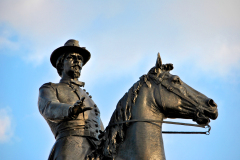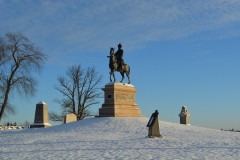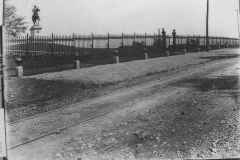Dedicated: June 5, 1896.
Location: East Cemetery Hill. The sculpture is located where General Hancock rallied the retreating Union forces on the evening of July 1, 1863. Captain Henry Bingham of Hancock’s staff gave the oration at the dedication.
Description: An equestrian portrait of General Winfield Scott Hancock with his proper left hand holding the horse’s reins and his proper right hand extended at his side. The sculpture rests atop a rectangular base adorned with rectangular inscription plaques. In 1902, the monument was stuck by lightning; the pedestal damaged. It was repaired by the Van Amringe Granite Company.
National Park Service List of Classified Monuments Number: MN300.
Sculptor: Elwell, Frank Edwin, 1858-1922, sculptor.
About Major General Winfield Scott Hancock
 Hancock was nicknamed “The Superb” or “The Thunderbolt of the Army of the Potomac.” He was born on February 14, 1824 in Norristown, Pennsylvania and graduated from West Point in 1844. He served with distinction in the Mexican War, where he was wounded in the knee.
Hancock was nicknamed “The Superb” or “The Thunderbolt of the Army of the Potomac.” He was born on February 14, 1824 in Norristown, Pennsylvania and graduated from West Point in 1844. He served with distinction in the Mexican War, where he was wounded in the knee.
Hancock was given an infantry brigade in the Army of the Potomac and earned the sobriquet, “The Superb,” for his services at Williamsburg. Active throughout the Seven Days, he first assumed division command at Antietam, leading his men against the Bloody Lane. He was wounded in the abdomen at Fredericksburg and again at Chancellorsville. When Darius Couch resigned as commander of the II Corps over Hooker’s generalship, Hancock was given command.
Although a new corps commander, Hancock played a pivotal role in securing the Union’s victory at Gettysburg, active on all three days, including July 3, where he was seriously wounded in the thigh. He was famously quoted as saying, “There are times when a corps commander’s life does not count” shortly before he was wounded. Hancock’s wound was severe and although he resumed command of the II Corps for the Overland Campaign, the wound troubled him for the rest of the War, and he gave up field command in November 1864.
After the War, Hancock ran for president, losing to James Garfield, upon which time he mostly retired from public life. He died on February 9, 1886 and is memorialized multiple times at Gettysburg (including on the Pennsylvania State Monument) and in other places, including Washington D.C.
Other Monuments to General Hancock
Equestrian Monument | Wounding Site Marker | Headquarters | Armistead – Hancock Monument


















